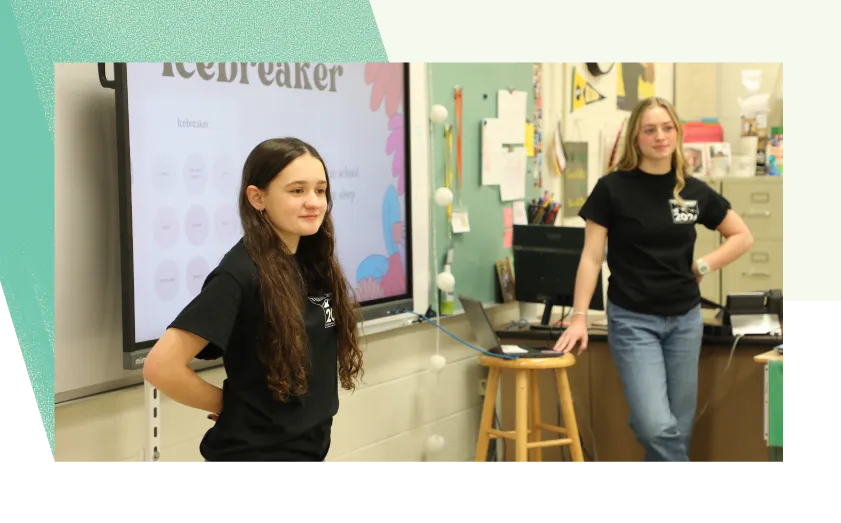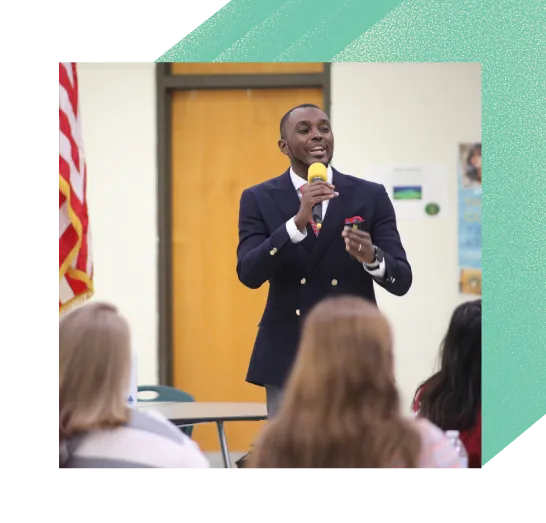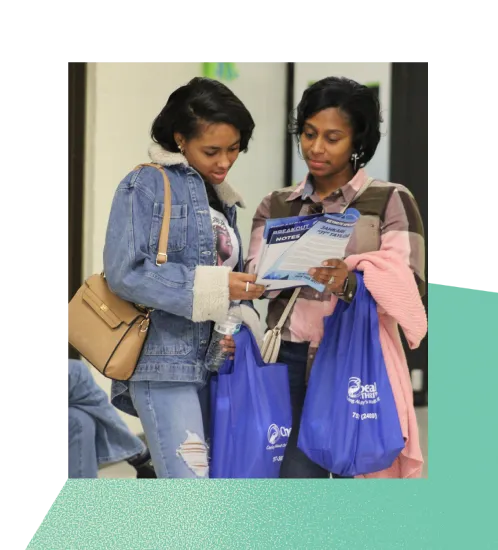School Shoutout: When Students Speak Up
How Chesapeake Public Schools’ student-led summit helped close the gap between teens and parents


SCHOOL SHOUTOUT
When Students Speak Up
Elevating Student Voice to Connect Generations
On a Saturday in late February, Kiera, a high school senior at Chesapeake Public Schools, stood in front of a group of parents and students, ready to speak. In a presentation titled “Introvert’s Guide to High School & More,” she unpacked the differences between introversion and social anxiety, even offering adaptive strategies and resources for further learning. Elsewhere in the school, other presentations were happening at the same time on topics like how to avoid peer pressure online and the differences between debit and credit cards.
These presentations (plus much more) were part of the Virginia district’s second-ever Teen Summit. The 2024 event, held at one of the district’s seven high schools, included a resource fair, a keynote speaker, free lunch and 20 different breakout sessions. More than likely you’ve heard of and even attended events like this—so what makes Chesapeake’s Teen Summit so special? From selecting session topics and speakers to marketing the event to leading breakout sessions themselves—the summit was entirely student-led.
In a recent family survey, 76% of Chesapeake parents requested academic and social-emotional support for their secondary students. That’s not so surprising when we consider how different school is now than it was 20-plus years ago, when many of today’s parents were students themselves. That’s one reason why the district’s Family and Community Engagement Office decided to spearhead the Teen Summit.

And if the summit was student-led, then Director of Engagement Andrea Vail and Family and Community Engagement Specialist Laura Lerf were following closely behind, supporting the students every step of the way. Before beginning their work in family engagement, Vail and Lerf both held other positions in the district where they worked closely with students. “We heard firsthand about the things students were going through,” Lerf tells us. “Yes, they deal with a lot of the same things we dealt with growing up, but they also deal with all this extra stuff, like social media. They have so much added pressure and stress.”
Lerf and Vail understood well that one of the best ways to support the district’s teens would be to support the district’s families. And with so many families requesting academic and social-emotional support for their teens, they knew they needed to recruit expert help. But if school is so vastly different now than it was for today’s adults, what experts could Lerf and Vail turn to? The answer was obvious: The experts were the students.
Student-Led Planning
Lerf and Vail began by asking students what they wished their parents knew. Some brought up topics Lerf and Vail would have never thought of. “Our student intern brought up abusive relationships, burner phones and controlling partners,” Vail tells us. “That’s how we started piecing together how impactful it would be for parents to hear from kids.”

Chesapeake Public Schools has a citywide student council that meets every month, comprised of student officers from each high school in the district. The group’s consistent meeting schedule, coupled with their standing as elected representatives of their schools, made the council the perfect team to help Lerf and Vail get the summit off the ground.
Working with the council, they determined the event should be in the late morning, which would allow students to sleep in—and hopefully boost attendance. They decided on their preferred keynote speaker, a former teacher from the district who is now an educational consultant and motivational speaker. They also identified other adults in the community who would be good fits for various breakout sessions; the owner of a local gym, for instance, could talk about healthy habits. As they planned, students also discussed the best audience for each topic—students, parents or both.
“It was interesting to see what they came up with,” says Vail. For example, students created a high-speed video of a day in the life of a high schooler, from the perspective of an athlete, someone in the marching band, and other students throughout the school. According to Vail, the students wanted to show parents the types of stressors today’s teens encounter in day-to-day life. “It’s so easy for parents to say, ‘What do you have to be stressed about? You’re just a teenager,’” she says. “So it was important to our students to find a way to say, ‘Look, we are stressed out. We want you to understand. Don’t dismiss us.’”
“I enjoyed my time getting adults to see things from a teenager’s point of view,” says Jalisa, a citywide student council member. “My experience at Teen Summit helped me gain the confidence and leadership skills needed to be a bridge between parents and their kids.”
Student-Led Promotion
“When it came to promoting the event, we knew having student input would help increase attendance from all our different middle and high schools,” Vail tells us. That’s why they left it up to the council members to decide how to promote the event at their respective schools. Some of the students even decided to go down to the middle schools at lunch and hand out flyers. “I love that,” Vail tells us, “because if you’re in middle school and a high school kid invites you to do something, you’ll want to go.”
Of course, as with any good marketing campaign, the students also had a digital strategy—one that may very well change the district’s approach to online promotion moving forward. The students believed that Instagram would be the best platform for connecting with other students and their families. But while Chesapeake’s individual schools already had Instagram profiles, the district did not—which, according to the students, was a mistake.
“The students told us we had to get on Instagram,” Lerf recalls. “They basically said, ‘Not as many kids are on Facebook as you think.’ Kids really tell it like it is.” And superintendent Dr. Jared Cotton, who attends all the citywide student council meetings, took the students’ feedback to heart. After the meeting, he mentioned to Lerf and Vail that it might be in Chesapeake’s best interest to create a districtwide Instagram account—so that’s exactly what the district did.
In the meantime, students made ample use of their schools’ accounts, the student council’s social media platforms, and even their own personal platforms—all while using district hashtags like #TeenSummitCPS or #CPSFACE to give their various online efforts an element of cohesion.
Student-Led Implementation
In addition to organizing and planning the Teen Summit, students were also crucial to the event’s day-of execution. Student volunteers throughout the entire event helped keep things running smoothly—and, like we said earlier, a number of the presenters were students themselves. Most student presenters were members of the citywide student council; however, some students outside the council were also tapped as co-presenters. At the very last council meeting before the summit, the students did a run-through. “They actually got up and presented all of their topics,” Lerf says, “and we gave them some tips and things to think about. They really worked hard.”
Part of what made Chesapeake’s Teen Summit so effective is that it gave parents a chance to hear from young people other than their own children. Prior to the event, Vail and Lerf had heard from both students and families that parents don’t always listen to their own kids. “When it’s your kid, you think they’re giving you an excuse,” Vail explains, “but when you hear from multiple young people about the same stressors, that’s pretty powerful.”
And the students would agree. Kaylee, another council member, remembers how many different families showed up at the summit with the same concerns. “I loved seeing the kids and parents interact and ask questions that not only helped them, but others in the room who had the same questions,” she says. It was also good for the students to realize that they were not alone in their problems, either. “My experience with the Teen Summit allowed me to connect to people my age and younger,” Kaylee adds, “to be there as a guide for everyday struggles that teenagers go through that aren’t talked about enough.”
When all was said and done, the Teen Summit proved successful, with 96% of attendees rating the event at a four or five out of five in a post-event survey. One parent even went so far as to say, “This was one of the greatest things that Chesapeake Public Schools has done for us.”
Stronger Relationships,
Stronger Reputation
“People in our broader community know that this is a premier school district. They know we’re going to do whatever it takes to get our students across the graduation stage,” Vail tells us. “Our reputation is that we care.” And what better way to show you care than to invest in relationships—whether that’s the community’s relationship to the district, students’ relationships to each other, or families’ relationships to their kids?
“There aren’t many things that secondary students and parents can do together,” says Lerf. But the Teen Summit provided them that opportunity. “I always wonder what kind of conversations the summit sparks on the car ride home,” Lerf adds. “I’ve been reading more and more that the car is the best place to have hard conversations with kids. You don’t have to make eye contact. There’s a definite end time. So it just makes me wonder—what do our parents and teens talk about once they leave the summit?”

In addition to helping strengthen the relationship between teens and their parents, the summit also offered opportunities for parents to forge relationships with other families in the same boat. Even if parents don’t understand what it’s like to be a teenager today, so many of them want to. Putting them in community with other adults who want the same thing can only do good.
Parents also got the chance to talk with school staff and even establish connections to local resources. It’s no secret that today’s youth are coming of age in the midst of a mental health crisis. According to the Centers for Disease Control and Prevention, teens’ mental health today is “significantly worse” than it was a decade ago. That’s why the Teen Summit’s resource fair spotlighted mental health resources ranging from integrated behavioral healthcare to inpatient and outpatient services. “It’s nice for parents to just go pick up a pamphlet to see what’s available because sometimes it’s hard to make that phone call,” Vail tells us.
Teenagers will always live in a very different world than the one their parents knew as kids, and reaching beyond the generational divide can sometimes feel impossible. But that doesn’t mean it’s not worth trying. And as is often the solution to social divides, one of the best places to start is with strengthening relationships—which is exactly what Chesapeake did. The Teen Summit helped build relationships between students, between parents and children, and between parents and other adults. And at the center of all these relationships is Chesapeake Public Schools, doing whatever is necessary to support students, to help families stay connected and to prove they’re a district that cares.

